Native Komplete Kontrol S49 MK2 Owner's manual
- Category
- Supplementary music equipment
- Type
- Owner's manual
This manual is also suitable for


Table of Contents
1. Disclaimer .................................................................................................................. 1
2. Welcome to KOMPLETE KONTROL ............................................................................ 2
2.1. Document Conventions ..................................................................................... 2
2.2. New Features in KOMPLETE KONTROL 2.1.6 ................................................... 3
2.3. New Features in KOMPLETE KONTROL 2.1.3 ................................................... 4
2.4. New Features in KOMPLETE KONTROL 2.1.0 ................................................... 4
2.5. Box Contents ................................................................................................... 5
2.6. System Requirements ....................................................................................... 5
2.7. Accessibility ..................................................................................................... 6
2.7.1. Keyboard Overview ................................................................................ 6
2.7.2. Activating Accessibility Features .............................................................. 8
2.7.3. Training Mode ........................................................................................ 9
2.7.4. Feature Overview and Keyboard Shortcuts .............................................. 9
3. The KOMPLETE KONTROL Workflow ........................................................................ 11
4. Setting up KOMPLETE KONTROL ............................................................................ 12
4.1. Connecting the Keyboard to the Computer ....................................................... 12
4.2. Setting up the Stand-Alone Application ............................................................ 13
4.3. Setting up Host Integration .............................................................................. 14
4.3.1. Setting up Apple Logic Pro X and GarageBand ...................................... 15
4.3.2. Setting up Steinberg Cubase/Nuendo .................................................... 16
4.3.3. Setting up Ableton Live ......................................................................... 16
4.3.4. Setting up PreSonus Studio One ........................................................... 17
4.4. Connecting Pedals to the Keyboard ................................................................. 17
4.5. Connecting External MIDI Equipment to the Keyboard ...................................... 20
5. Software Overview .................................................................................................... 21
5.1. Header .......................................................................................................... 21
5.2. Browser ......................................................................................................... 22
5.2.1. Library Pane ........................................................................................ 23
5.2.2. Product Selector ................................................................................... 24
5.2.3. Files Pane ............................................................................................ 25
5.2.4. Browser on the Keyboard ...................................................................... 27
5.3. Perform Panel ................................................................................................ 27
5.4. Plug-in Panel .................................................................................................. 28
5.5. Plug-in Chain Panel ........................................................................................ 28
5.6. MIDI Assignment Editor .................................................................................. 29
5.7. Plug-in Area ................................................................................................... 29
5.8. Sampler Plug-In .............................................................................................. 30
5.8.1. Envelopes ............................................................................................ 31
5.9. Audio Plug-In ................................................................................................. 33
6. Keyboard Overview .................................................................................................. 35
6.1. Perform and Edit Section ................................................................................ 36

6.2. Transport Section ........................................................................................... 37
6.3. Control Section ............................................................................................... 38
6.4. Mode Buttons ................................................................................................. 38
6.5. 4-D Encoder ................................................................................................... 39
6.6. Keybed and Light Guide .................................................................................. 40
6.7. Touch Strip ..................................................................................................... 40
6.8. Transpose and Fixed Velocity Buttons .............................................................. 41
7. Global Controls and Preferences ............................................................................... 42
7.1. Instrument Views ............................................................................................ 42
7.1.1. Default View ......................................................................................... 43
7.1.2. Additional View ..................................................................................... 43
7.1.3. Edit View ............................................................................................. 44
7.2. Switching Instances ........................................................................................ 45
7.3. Transport and Tempo ...................................................................................... 46
7.3.1. Resetting the Clock .............................................................................. 46
7.3.2. Adjusting Tempo ................................................................................... 47
7.4. Adjusting Master Volume ................................................................................. 47
7.5. Preferences ................................................................................................... 47
7.5.1. Preferences – Audio Page .................................................................... 48
7.5.2. Preferences – MIDI Page ...................................................................... 49
7.5.3. Preferences – General Page ................................................................. 50
7.5.4. Preferences – Library Page ................................................................... 51
7.5.5. Preferences – Plug-ins Page ................................................................. 53
7.5.6. Preferences - Features Page ................................................................. 55
7.6. Keyboard Settings .......................................................................................... 56
7.7. Loading a Plug-in in Default State .................................................................... 56
8. MIDI Communication ................................................................................................ 58
8.1. Mapping MIDI Controls to Third-Party Controllers ............................................. 59
8.1.1. Setting up a Third-Party Controller ......................................................... 61
8.1.2. Assigning Knobs to a Third-Party Controller ........................................... 62
8.1.3. Assigning Buttons to a Third-Party Controller ......................................... 62
8.1.4. Enabling Takeover Mode ....................................................................... 63
8.1.5. Hardware Configuration for MIDI Mapping .............................................. 64
8.1.6. Share Mapping Across Instances .......................................................... 64
8.2. Host Automation ............................................................................................. 65
8.2.1. Recording Automation .......................................................................... 65
8.2.2. Automation IDs for the Perform Panel .................................................... 65
8.3. Using the Keyboard in MIDI Mode ................................................................... 66
8.4. Using the Keyboard as Stand-Alone MIDI Controller ......................................... 67
9. Using the MIDI Assignment Editor .............................................................................. 68
9.1. The Mapping System ...................................................................................... 68
9.2. Opening the MIDI Assignment Editor ............................................................... 69
9.3. Assigning MIDI Messages to Control Elements ................................................. 69
9.4. Renaming Control Elements ............................................................................ 70
9.5. Creating a New MIDI Template ........................................................................ 71

9.6. Renaming MIDI Templates .............................................................................. 71
9.7. Creating Key Zones ........................................................................................ 72
9.7.1. About Key Zones .................................................................................. 72
9.7.2. Splitting Key Zones ............................................................................... 73
9.7.3. Selecting MIDI Channels for Key Zones ................................................. 74
9.7.4. Recoloring Key Zones ........................................................................... 74
9.7.5. Resizing Key Zones .............................................................................. 75
9.7.6. Disabling Key Zones ............................................................................. 76
9.7.7. Deleting a Key Zone ............................................................................. 77
9.7.8. Transposing Key Zones ........................................................................ 78
9.8. MIDI Message Types and Assignments ............................................................ 79
9.8.1. MIDI Message Types – Type Menu ........................................................ 79
9.8.2. Assignments for Knobs ......................................................................... 80
9.8.3. Assignments for Buttons ....................................................................... 80
9.8.4. Assignments for Key Zones ................................................................... 81
9.8.5. Assignments for the Touch Strip ............................................................ 82
9.8.6. Assignments for Switch Pedals .............................................................. 83
9.8.7. Assignments for Continuous Pedals ....................................................... 83
10. Host Integration ...................................................................................................... 85
10.1. Integration with MASCHINE .......................................................................... 85
10.1.1. Basic Control Functions ...................................................................... 86
10.1.2. Advanced Integration Control Functions ............................................... 87
10.2. Integration with Apple Logic Pro X and GarageBand ....................................... 90
10.3. Integration with Ableton Live .......................................................................... 92
10.4. Integration with Steinberg Cubase and Nuendo .............................................. 93
10.5. Integration with PreSonus Studio One ............................................................ 94
10.6. Integration with Hosts using MCU Protocol ..................................................... 96
11. Browsing the Library ................................................................................................ 98
11.1. Browser Basics ............................................................................................. 98
11.1.1. Product Types: Instruments, Loops, One-shots and Effects ................... 98
11.1.2. Loops and One-shots .......................................................................... 99
11.1.3. About the Library and Meta-Information ................................................ 99
11.1.4. Browsing the Library vs. Browsing Your Hard Disks ............................... 99
11.2. Opening the Browser .................................................................................... 100
11.3. Loading Preset Files .................................................................................... 101
11.4. Choosing Between Factory Content and User Content ................................... 102
11.5. Filtering Preset Files by Product .................................................................... 102
11.6. Filtering Preset Files by Bank ....................................................................... 105
11.7. Resetting the Product Selection .................................................................... 107
11.8. Types and Characters Tags .......................................................................... 108
11.8.1. Filtering Preset Files by Types and Characters .................................... 109
11.8.2. Selecting Multiple Tags from the Same Level ....................................... 111
11.9. Working with Favorites ................................................................................. 112
11.9.1. Adding Preset Files to the Favorites .................................................... 112
11.9.2. Displaying Favorites in the Results List ............................................... 114
11.9.3. Removing Preset Files from the Favorites ........................................... 115

11.10. Performing a Text Search ........................................................................... 115
11.11. Displaying Preset File Information ............................................................... 116
11.12. Auditioning your Preset Files ....................................................................... 116
12. Working with Effects ............................................................................................... 118
12.1. Opening the Plug-in Chain Panel .................................................................. 118
12.2. Adding Effects ............................................................................................. 118
12.3. Selecting Plug-in Slots ................................................................................. 121
12.4. Reordering Effects ....................................................................................... 121
12.5. Scrolling the Plug-in Chain ........................................................................... 122
12.6. Bypassing Effects ........................................................................................ 122
12.7. Removing Effects ......................................................................................... 123
13. Working with Loops and One-Shot Samples ............................................................ 125
13.1. Sampler Plug-In and Audio Plug-In Use Cases .............................................. 125
13.2. Loading One-Shot Samples and Loops ......................................................... 125
13.3. Opening the Audio Plug-In or Sampler Plug-In ............................................... 126
13.4. Switching between the Audio Plug-In and the Sampler Plug-In ....................... 127
13.5. Playback Behavior of Audio Plug-In in Host Software ..................................... 127
14. Managing the Library ............................................................................................. 128
14.1. Saving Preset Files to the User Library .......................................................... 128
14.2. Deleting User Preset Files from the User Library ............................................ 130
14.3. Editing the Tags and Properties of User Preset Files ...................................... 130
14.4. Syncing Multiple Instances ........................................................................... 133
14.5. Working with the Files Pane ......................................................................... 134
14.5.1. Additional Results List Features List in the Files Pane .......................... 134
14.5.2. Navigating to File Locations with the Location Bar ............................... 135
14.5.3. Navigating to Recent File Locations .................................................... 135
14.5.4. Working with File Location Favorites ................................................... 135
14.6. Loading VST Plug-ins .................................................................................. 136
14.7. Installing NKS Instruments ........................................................................... 137
14.8. Importing KOMPLETE KONTROL-Compatible User Files ............................... 139
15. Controlling Instrument, Loop, One-shot and Effect Parameters ................................. 141
15.1. About Pre-Mapped Instruments, Loops, One-shots and Effects ....................... 141
15.2. Adjusting Parameters ................................................................................... 141
15.3. Switching Parameter Pages ......................................................................... 141
15.4. Customizing Parameter Mappings using the Plug-in Panel ............................. 142
16. Smart Play – Playing and Editing Scales and Chords ............................................... 144
16.1. A Note about Music Theory .......................................................................... 144
16.2. Activating the Scale Engine .......................................................................... 145
16.3. Selecting and Playing a Scale ...................................................................... 146
16.4. Playing Chords ............................................................................................ 146
16.5. Editing Scales and Chords ........................................................................... 147
16.6. Setting the SCALE Parameters ..................................................................... 147
16.6.1. SCALE Root Note .............................................................................. 148

16.6.2. SCALE Bank and Type ...................................................................... 148
16.7. Setting the KEY MODE Parameter ................................................................ 152
16.8. Setting the CHORD Parameters ................................................................... 153
16.8.1. CHORD Mode ................................................................................... 153
16.8.2. CHORD Type .................................................................................... 155
16.8.3. CHORD Position ............................................................................... 157
17. Smart Play – Playing and Editing Arpeggiator Sequences ........................................ 158
17.1. Playing Arpeggiator Sequences .................................................................... 158
17.2. Using a Sustain Pedal to Control the Arpeggiator ........................................... 159
17.3. Using Arpeggiator Snapshots on the Keyboard .............................................. 159
17.4. Editing the Arpeggiator ................................................................................. 160
17.5. MAIN Parameters ........................................................................................ 160
17.5.1. MAIN Mode ....................................................................................... 161
17.5.2. MAIN Type ........................................................................................ 161
17.6. RHYTHM Parameters .................................................................................. 161
17.6.1. RHYTHM Rate .................................................................................. 162
17.6.2. RHYTHM Sequence .......................................................................... 163
17.6.3. RHYTHM Swing ................................................................................ 163
17.7. OTHER Parameters ..................................................................................... 164
17.7.1. OTHER Octaves ................................................................................ 164
17.7.2. OTHER Dynamic ............................................................................... 164
17.7.3. OTHER Gate ..................................................................................... 165
17.8. ADVANCED Parameters .............................................................................. 165
17.8.1. ADVANCED Retrigger ........................................................................ 165
17.8.2. ADVANCED Repeat ........................................................................... 166
17.8.3. ADVANCED Offset ............................................................................ 166
17.8.4. ADVANCED Inversion ........................................................................ 166
17.9. RANGE Parameters ..................................................................................... 166
17.9.1. RANGE Min. Key ............................................................................... 167
17.9.2. RANGE Max. Key .............................................................................. 167
17.10. HOLD Parameter ....................................................................................... 167
18. Envelopes ............................................................................................................. 169

1. DISCLAIMER
The information in this document is subject to change without notice and does not represent a
commitment on the part of Native Instruments GmbH. The software described by this document is
subject to a License Agreement and may not be copied to other media. No part of this publication
may be copied, reproduced or otherwise transmitted or recorded, for any purpose, without prior
written permission by Native Instruments GmbH, hereinafter referred to as Native Instruments.
“Native Instruments”, “NI” and associated logos are (registered) trademarks of Native Instruments
GmbH.
Mac, macOS, GarageBand, Logic and iTunes are registered trademarks of Apple Inc., registered
in the U.S. and other countries.
Windows and DirectSound are registered trademarks of Microsoft Corporation in the United States
and/or other countries.
Ableton Live™ and LINK™ are a trademarks of Ableton AG.
ASIO and VST are a trademark and software of Steinberg Media Technologies GmbH.
All other trademarks are the property of their respective owners and use of them does not imply
any affiliation with or endorsement by them.
Document authored by: Native Instruments GmbH
Software version: 2.1.6 (09/2019)
Hardware version: KOMPLETE KONTROL S-Series MK2
Special thanks to the Beta Test Team, who were invaluable not just in tracking down bugs, but in
making this a better product.
Disclaimer
1

2. WELCOME TO KOMPLETE KONTROL
Thank you for choosing KOMPLETE KONTROL!
The KOMPLETE KONTROL software and its dedicated keyboard—the KOMPLETE KONTROL S-
Series—form a tightly integrated music production and performance system that brings all the
sounds from KOMPLETE and the Native Kontrol Standard (NKS) to the heart of your workflow.
KOMPLETE KONTROL offers advanced integration with a number of hosts and provides full con-
trol of any Instruments supporting NKS, both from Native Instruments and partners. The keyboard
lets you browse your Instruments, Loops, One-Shots and Effects in an intuitive way and play them
creatively with KOMPLETE KONTROL’s unique Scale engine and Arpeggiator.
We hope you enjoy this fantastic instrument as much as we do.
—The team at Native Instruments
2.1. Document Conventions
This document uses particular formatting to point out special facts and to warn you of potential is-
sues. The icons introducing the following notes let you see what kind of information can be expec-
ted:
The speech bubble icon indicates a useful tip that may often help you to solve a task
more efficiently.
The exclamation mark icon highlights important information that is essential for the
given context.
The red cross icon warns you of serious issues and potential risks that require your
full attention.
Furthermore, the following formatting is used:
• Text appearing in (drop-down) menus (such as Open…, Save as… etc.) in the software and
paths to locations on your hard disk or other storage devices is printed in italics.
• Text appearing elsewhere (labels of buttons, controls, text next to checkboxes etc.) in the soft-
ware is printed in blue. Whenever you see this formatting applied, you will find the same text
appearing somewhere on the screen.
• Text appearing on the displays of the controller is printed in light grey. Whenever you see this
formatting applied, you will find the same text on a controller display.
Welcome to KOMPLETE KONTROL
2

• Text appearing on labels of the hardware controller is printed in orange. Whenever you see
this formatting applied, you will find the same text on the controller.
• Important names and concepts are printed in bold.
• References to keys on your computer’s keyboard you’ll find put in square brackets (e.g., “Press
[Shift] + [Enter]”).
• Single instructions are introduced by this play button type arrow.
Results of actions are introduced by this smaller arrow.
Naming Convention
Throughout the documentation we will refer to KOMPLETE KONTROL keyboard (or just key-
board) as the hardware controller and KOMPLETE KONTROL software as the software installed
on your computer.
Unlabeled Buttons on the Keyboard
The buttons and knobs above and below the displays on the KOMPLETE KONTROL keyboard do
not have labels.
The unlabeled buttons and knobs on the KOMPLETE KONTROL keyboard.
For better reference, we applied a special formatting here: throughout the document, the elements
are capitalized and numbered, so the buttons above the displays are written Button 1 to Button 8,
while the knobs under the displays are written Knob 1 to Knob 8.
2.2. New Features in KOMPLETE KONTROL 2.1.6
The following new features have been added to KOMPLETE KONTROL:
PreSonus Studio One Support for KOMPLETE KONTROL
KOMPLETE KONTROL keyboards now support integration in PreSonus Studio One.
For more information, refer to Integration with PreSonus Studio One.
Welcome to KOMPLETE KONTROL
3

Steinberg Cubase/Nuendo Support for KOMPLETE KONTROL A-Series
and M32
KOMPLETE KONTROL A-Series and M32 keyboards now support integration in PreSonus Studio
One.
2.3. New Features in KOMPLETE KONTROL 2.1.3
The following new features have been added to KOMPLETE KONTROL:
Audio Plug-in
The new Audio plug-in specializes in keeping audio loops playing in-sync with the project in your
host software and has the optional ability to do so without influencing the key of the loop. Further-
more, you can transpose the loop while it plays so that it fits the key of your song.
For more information on the Audio plug-in, refer to Audio Plug-In.
For more information on using the Audio plug-in, refer to Working with Loops and One-Shot Sam-
ples.
MCU Support for KOMPLETE KONTROL S-Series MK2
KOMPLETE KONTROL S-Series MK2 now supports integration in hosts with MCU control.
For more information, refer to Integration with Hosts using MCU Protocol.
MIDI Control Takeover Mode for Third-Party Controllers
When using third-party controllers, you can now enable Takeover mode to prevent potential pa-
rameter jumps caused by mismatching knob positions between software and hardware.
For more information, refer to Enabling Takeover Mode.
Improvements to Host Integration
Previously, you had to start KOMPLETE KONTROL as a stand-alone application to scan your li-
brary for Instruments, Samples, and Effects before using the plug-in in your host. This step is now
no longer necessary. Instead, when you use KOMPLETE KONTROL in your host directly after in-
stallation, a dialog is presented, allowing you to scan your library.
2.4. New Features in KOMPLETE KONTROL 2.1.0
The following new features have been added to KOMPLETE KONTROL:
MIDI Mapping for Third-Party Controllers
• It is now possible to control some of KOMPLETE KONTROL's parameters via a third-party
MIDI controller. For more information, refer to MIDI Communication.
Sounds.com Integration
• Browse on Sounds.com, create your own collections of loops and one-shots and send them di-
rectly to the KOMPLETE KONTROL Browser.
Welcome to KOMPLETE KONTROL
4

Improvements to the Browser
• Samples are now cataloged in separate Loops and One-shots tabs in the Browser. For more
information, refer to Loops and One-shots.
• Previews of Loops selected in the Browser will be played in sync with the current project. When
a loop is selected with Prehear turned on, it will begin playing immediately in-sync with the
project if transport is running. For more information, refer to Loops and One-shots
• Filters and product selections will be remembered when switching between Content types and
Factory/User Libraries in the Browser.
• Browser content synchronization between multiple running instances. When running multiple
instances of KOMPLETE KONTROL, either as Standalone and/or as a plug-in, updates to the
Library will be synced across the instances. For example, if you delete a sample from your
User Library in one instance, the sample will no longer be present in the other instances. Simi-
larly, if you save a preset in one instance, that preset will then be available in the other instan-
ces also.
2.5. Box Contents
The box contains the following items:
• KOMPLETE KONTROL keyboard
• USB cable
The included 3 meter USB cable only works in conjunction with the KOM-
PLETE KONTROL S88 keyboard.
• Power supply (only included in the KOMPLETE KONTROL S88 box)
• Information flyer providing:
• the hardware serial number of the KOMPLETE KONTROL keyboard
• a web link for downloading the KOMPLETE KONTROL software and the KOMPLETE SE-
LECT software bundle
• Safety Instructions flyer
2.6. System Requirements
For KOMPLETE KONTROL to fully function as indented, your system needs to meet certain re-
quirements. The latest KOMPLETE KONTROL system requirements and compatibility information
is available here:
http://www.native-instruments.com/komplete-kontrol-s-series/specifications/
KOMPLETE
KOMPLETE KONTROL is optimized for use with KOMPLETE SELECT, KOMPLETE and KOM-
PLETE ULTIMATE.
Welcome to KOMPLETE KONTROL
5

The latest KOMPLETE system requirements and compatibility information is available here:
http://www.native-instruments.com/products/komplete/
2.7. Accessibility
KOMPLETE KONTROL offers a set of accessibility features for visually-impaired users. These are
focused exclusively on the KOMPLETE KONTROL keyboard itself and include speech output via
your computer for the following features:
• Perform, Transpose, Page left / right buttons
• All Browser functions
• Instance switching
• The current edit mode, including the Plug-in panel and the Perform panel (Scale, Arp)
• Names of parameters and parameter sections when touching knobs, including all edit modes
• Tempo (KOMPLETE KONTROL stand-alone application only)
The accessibility features are particularly useful when combined with KOM-
PLETE KONTROL’s host integration and Apple VoiceOver in Apple Logic Pro X and
GarageBand.
2.7.1. Keyboard Overview
The buttons and knobs on the KOMPLETE KONTROL keyboard are organized in the following
groups:
• Perform and Edit section
• Transport section
• Solo and Mute buttons
• Preset and Page buttons
• Arrange buttons (only functional in MASCHINE)
• Control section
• Navigation and Mode buttons
• 4-Directional Push Encoder (referred to as the 4-D encoder)
• Transpose and Fixed Velocity buttons
The Perform and Edit section is located at the top left of the keyboard. It contains six buttons that
are arranged in two rows.
The buttons in the first row are (from left to right):
• SHIFT
• SCALE (Edit)
• ARP (Edit)
The buttons in the second row are (from left to right):
Welcome to KOMPLETE KONTROL
6

• UNDO (Redo)
• QUANTIZE
• AUTO
The Transport section is located directly below the Perform and Edit section. It contains six buttons
that are arranged in two rows.
The buttons in the first row are (from left to right):
• LOOP
• METRO
• TEMPO
The buttons in the second row are (from left to right):
• PLAY (Restart)
• REC (Count-In)
• STOP
The Solo and Mute buttons are located to the top right of the Perform and Edit section. The two
buttons are arranged in a row.
The buttons are (from left to right):
• Mute
• Solo
The Preset and Page buttons are located to the bottom right of the Perform and Edit section, be-
low the Solo and Mute buttons. The four buttons are arranged in a column.
The buttons are (from top to bottom):
• PRESET Up
• PRESET Down
• Page Left and Page Right (next to each other)
The Arrange buttons, which are only functional in MASCHINE, are located to the right of the Solo
and Mute buttons and the Preset and Page buttons. The five buttons are arranged in a column.
The buttons are (from top to bottom):
• SCENE
• PATTERN
• TRACK
• KEY MODE
• CLEAR
The Control section is located in the center of the KOMPLETE KONTROL keyboard. It contains
eight buttons and eight knobs. The buttons are arranged in a row at the very top of the keyboard.
The knobs are arranged in a row directly above the keybed.
Welcome to KOMPLETE KONTROL
7

The Navigation and Mode buttons are on the top right of the KOMPLETE KONTROL keyboard.
The six buttons are arranged in two rows.
The buttons in the first row are (from left to right):
• BROWSER
• PLUG-IN
• MIXER
The buttons in the second row are (from left to right):
• INSTANCE
• MIDI
• SETUP
The 4-D encoder is located directly below the Navigation and Mode buttons.
The Transpose and Fixed Velocity buttons are located at the far left of the keyboard next to the
keybed and directly above the Pitch and Modulation wheels. The three buttons are arranged in a
row.
The buttons are (from left to right):
• FIXED VEL (TS Mode)
• OCT Down
• OCT Up
2.7.2. Activating Accessibility Features
In order to activate or deactivate the accessibility features from the KOMPLETE KONTROL key-
board while the KOMPLETE KONTROL software is running:
1. Press and hold the SHIFT button on the top left of the keyboard.
2. While holding SHIFT, press the MIXER button on the top right of the keyboard.
The accessibility features are activated or deactivated.
When the accessibility features are activated, you can choose whether or not speech output
should be enabled for names of Preset files while browsing:
1. Press and hold the SHIFT button on the top left of the keyboard.
2. While holding SHIFT, press Button 5 in the Control section.
Speech output for names of Preset files while browsing is enabled or disabled.
The accessibility features are designed to be used with the KOMPLETE KONTROL
plug-in. However, the KOMPLETE KONTROL stand-alone application must be
opened after initial installation and after installing additional Instruments and Effects.
This will ensure that all Instruments, Loops, One-shots and Effects are displayed
correctly in the KOMPLETE KONTROL Browser.
Welcome to KOMPLETE KONTROL
8

2.7.3. Training Mode
KOMPLETE KONTROL Training Mode makes it easy to locate a specific button or parameter with-
out accidentally triggering an action. When Training Mode is activated, all button presses and pa-
rameter names are announced but the corresponding action is not triggered.
Activating Training Mode
• To activate or deactivate Training Mode from the KOMPLETE KONTROL keyboard while the
KOMPLETE KONTROL software is running, double-press the SHIFT button on the top left of
the keyboard.
Training Mode is only available when the accessibility features have been activated.
2.7.4. Feature Overview and Keyboard Shortcuts
The following overview outlines the availability of accessibility features for different aspects of
KOMPLETE KONTROL from both the KOMPLETE KONTROL keyboard and the KOM-
PLETE KONTROL software. In the table you also can find the relevant keyboard shortcut.
Feature Accessi-
ble from
Keyboard
Keyboard Shortcut
Accessibility
Mode
Enable or disable Accessibility mode Yes SHIFT + MIXER
Enable or disable speech output for names of Preset
files
SHIFT + Button 5
Browser Browse for Factory and User Preset files Yes Page left button or Page
right button
Switch between Category and Vendor sorting Yes SHIFT + Knob 1
Set Preset file Favorites Yes SHIFT + Knob 4
Sort by Favorites SHIFT + Knob 3
Save and edit User Preset files No
Browse for NKS plug-ins from other vendors Yes Supported by default
Instrument
control
Adjust key Instrument parameters Yes Knob 1 – 8
Custom map Instrument parameters No
Smart Play Accessing Scale and Chord Parameters Yes SHIFT + SCALE Edit
Adjust Scale & Chord parameters Knob 1 – 8
Accessing Arp Parameters Yes SHIFT + ARP Edit
Adjust Arp parameters Knob 1 – 8
Selecting Parameter Pages Page left or Page right
Touch Strips Adjust Touch Strip parameters No
Tempo Adjust BPM Yes TEMPO + Knob 1
Training
mode
Find a control without accidentally triggering actions Yes
Welcome to KOMPLETE KONTROL
9

Feature Accessi-
ble from
Keyboard
Keyboard Shortcut
Enabling or disabling Training mode Yes Double-press SHIFT
Preferences Adjust software & hardware preferences No
Software dia-
log
Be notified if a dialog box opens in the software (dialog
content is not available for speech output)
Yes Supported by default
Accessibility for KOMPLETE KONTROL’s host integration is only available when us-
ing Apple VoiceOver in Logic Pro X and GarageBand. For more information about
KOMPLETE KONTROL’s host integration features, refer to Host Integration.
Welcome to KOMPLETE KONTROL
10

3. THE KOMPLETE KONTROL WORKFLOW
KOMPLETE KONTROL brings all the sounds from KOMPLETE and the Native Kontrol Standard
(NKS) to the center of your workflow. Its advanced integration in a number of hosts enables you to
quickly capture ideas, with immediate access to the sounds you need, all directly from the KOM-
PLETE KONTROL keyboard.
The KOMPLETE KONTROL workflow is streamlined to remove any obstacles when sketching out
a new song in a supported host:
1. Select a track that hosts the KOMPLETE KONTROL plug-in with the navigation controls on
the keyboard. This is made possible by KOMPLETE KONTROL’s advanced host integration.
2. Find Preset files you like from any of the Instruments and Effects in your KOMPLETE KON-
TROL Library by browsing with the keyboard, supported by the Browser’s filters and Preview
functions.
3. Use the keyboard’s Control section to adjust the loaded Instrument and Effect(s) and create
your own unique sound.
4. Optionally, you can enable KOMPLETE KONTROL’s Smart Play features to enrich your play-
ing with the Scale engine and the Arpeggiator.
5. Record a new clip in the host, conveniently controlling transport and loop functions directly
from the keyboard. Again, made possible by KOMPLETE KONTROL’s advanced host inte-
gration.
6. If you need to start over, undo and redo functions are right at your fingertips. To further refine
your recording, you can apply quantization and automation to a clip by pressing the corre-
sponding buttons on the keyboard.
You have quickly captured a musical idea and can continue sketching out a new song by re-
peating the process and layering more tracks.
Key Features
The following key features facilitate the KOMPLETE KONTROL workflow:
• Browser: The Browser is your interface for finding, loading and organizing Instruments, Loops,
One-Shots, Effects, and Preset files from the KOMPLETE KONTROL Library. For more infor-
mation, refer to Browsing the Library,Working with Effects, and Managing the Library.
• Instrument and Effect control: The Touch Strip and knobs on the keyboard are pre-mapped
to all KOMPLETE and NKS Instruments, Loops, One-shots and Effects for immediate control.
For more information, refer to Controlling Instrument, Loop, One-shot and Effect Parameters
and Assignments for the Touch Strip.
• Smart Play: The Scale engine and the Arpeggiator let you play and generate scales, chords,
and arpeggiator sequences. For more information, refer to Smart Play – Playing and Editing
Scales and Chords and Smart Play – Playing and Editing Arpeggiator Sequences.
• Host integration: Advanced integration in a number of hosts allows you control core function-
ality directly from the keyboard. For more information, refer to Setting up Host Integration and
Host Integration.
The KOMPLETE KONTROL Workflow
11

4. SETTING UP KOMPLETE KONTROL
This section provides basic setup information for using the KOMPLETE KONTROL stand-alone
software, and guides you through the process of integrating KOMPLETE KONTROL in supported
hosts.
The KOMPLETE KONTROL software is installed both as a stand-alone application as well as a
VST, Audio Unit, and AAX plug-in.
The KOMPLETE KONTROL stand-alone application directly communicates with your audio and
MIDI interfaces, which you can configure in the KOMPLETE KONTROL Preferences. When KOM-
PLETE KONTROL is used as a plug-in within a host, the communication with your audio and MIDI
interfaces is managed by the host.
For details about the audio and MIDI configuration of the host, and how to load plug-
ins, please refer to its documentation.
4.1. Connecting the Keyboard to the Computer
To connect the KOMPLETE KONTROL keyboard to your computer:
1. Attach the device end of the included USB cable to the USB socket on the rear panel of the
keyboard.
2. Attach the computer end of the USB cable to an available USB 2.0 (or later) port on your
computer.
3. Press the power switch on the rear panel of the keyboard to switch it on.
The keyboard is now detected by the operating system.
Setting up KOMPLETE KONTROL
12

Non-powered USB hubs are not supported. The keyboard should always be connec-
ted directly to the USB port of the computer, or be used with a powered USB hub.
4.2. Setting up the Stand-Alone Application
When you launch the KOMPLETE KONTROL software from its installation directory, it starts as a
stand-alone application independently from a host.
By default, the application uses the standard audio interface of your computer. In order to use an-
other audio interface, and receive MIDI notes from the keyboard, you need to configure the appli-
cation in the Preferences.
Configuring Audio Interface
1. In the KOMPLETE KONTROL menu click on Edit > Preferences to open the Preferences.
2. Click on Audio to display the Audio page.
3. Select the hardware driver supported by your audio interface from the Driver drop-down
menu.
4. Select the audio interface from the Device drop-down menu.
5. Under Routings, select the left and right output channels of your audio interface you want to
use for KOMPLETE KONTROL’s master output in the Komplete Kontrol Out 1 L and Kom-
plete Kontrol Out 1 R drop-down menus.
Preferences panel — Audio page.
Setting up KOMPLETE KONTROL
13

Enabling MIDI Control
1. Click on MIDI to display the MIDI page.
2. Click on Input to display the available devices for incoming MIDI signals.
3. Click the Komplete Kontrol checkboxes to activate incoming MIDI signals from the key-
board.
Preferences panel — MIDI page (entries may vary on your computer).
The software is configured and ready to be controlled with the keyboard.
The MIDI Output settings are required for using KOMPLETE KONTROL’s Smart
Play features with other MIDI instruments.
4.3. Setting up Host Integration
KOMPLETE KONTROL integrates with a number of hosts to facilitate a fluent workflow for per-
forming and recording music with your KOMPLETE KONTROL Library.
Advanced integration of KOMPLETE KONTROL is available in the following hosts:
• MASCHINE 2/3
• Apple Logic Pro X
• Apple GarageBand
• Ableton Live 10
• Steinberg Cubase Artist 8.5/9/9.5/10
• Steinberg Cubase Pro 8.5/9/9.5/10
Setting up KOMPLETE KONTROL
14
Page is loading ...
Page is loading ...
Page is loading ...
Page is loading ...
Page is loading ...
Page is loading ...
Page is loading ...
Page is loading ...
Page is loading ...
Page is loading ...
Page is loading ...
Page is loading ...
Page is loading ...
Page is loading ...
Page is loading ...
Page is loading ...
Page is loading ...
Page is loading ...
Page is loading ...
Page is loading ...
Page is loading ...
Page is loading ...
Page is loading ...
Page is loading ...
Page is loading ...
Page is loading ...
Page is loading ...
Page is loading ...
Page is loading ...
Page is loading ...
Page is loading ...
Page is loading ...
Page is loading ...
Page is loading ...
Page is loading ...
Page is loading ...
Page is loading ...
Page is loading ...
Page is loading ...
Page is loading ...
Page is loading ...
Page is loading ...
Page is loading ...
Page is loading ...
Page is loading ...
Page is loading ...
Page is loading ...
Page is loading ...
Page is loading ...
Page is loading ...
Page is loading ...
Page is loading ...
Page is loading ...
Page is loading ...
Page is loading ...
Page is loading ...
Page is loading ...
Page is loading ...
Page is loading ...
Page is loading ...
Page is loading ...
Page is loading ...
Page is loading ...
Page is loading ...
Page is loading ...
Page is loading ...
Page is loading ...
Page is loading ...
Page is loading ...
Page is loading ...
Page is loading ...
Page is loading ...
Page is loading ...
Page is loading ...
Page is loading ...
Page is loading ...
Page is loading ...
Page is loading ...
Page is loading ...
Page is loading ...
Page is loading ...
Page is loading ...
Page is loading ...
Page is loading ...
Page is loading ...
Page is loading ...
Page is loading ...
Page is loading ...
Page is loading ...
Page is loading ...
Page is loading ...
Page is loading ...
Page is loading ...
Page is loading ...
Page is loading ...
Page is loading ...
Page is loading ...
Page is loading ...
Page is loading ...
Page is loading ...
Page is loading ...
Page is loading ...
Page is loading ...
Page is loading ...
Page is loading ...
Page is loading ...
Page is loading ...
Page is loading ...
Page is loading ...
Page is loading ...
Page is loading ...
Page is loading ...
Page is loading ...
Page is loading ...
Page is loading ...
Page is loading ...
Page is loading ...
Page is loading ...
Page is loading ...
Page is loading ...
Page is loading ...
Page is loading ...
Page is loading ...
Page is loading ...
Page is loading ...
Page is loading ...
Page is loading ...
Page is loading ...
Page is loading ...
Page is loading ...
Page is loading ...
Page is loading ...
Page is loading ...
Page is loading ...
Page is loading ...
Page is loading ...
Page is loading ...
Page is loading ...
Page is loading ...
Page is loading ...
Page is loading ...
Page is loading ...
Page is loading ...
Page is loading ...
Page is loading ...
Page is loading ...
Page is loading ...
Page is loading ...
Page is loading ...
Page is loading ...
Page is loading ...
Page is loading ...
Page is loading ...
Page is loading ...
Page is loading ...
-
 1
1
-
 2
2
-
 3
3
-
 4
4
-
 5
5
-
 6
6
-
 7
7
-
 8
8
-
 9
9
-
 10
10
-
 11
11
-
 12
12
-
 13
13
-
 14
14
-
 15
15
-
 16
16
-
 17
17
-
 18
18
-
 19
19
-
 20
20
-
 21
21
-
 22
22
-
 23
23
-
 24
24
-
 25
25
-
 26
26
-
 27
27
-
 28
28
-
 29
29
-
 30
30
-
 31
31
-
 32
32
-
 33
33
-
 34
34
-
 35
35
-
 36
36
-
 37
37
-
 38
38
-
 39
39
-
 40
40
-
 41
41
-
 42
42
-
 43
43
-
 44
44
-
 45
45
-
 46
46
-
 47
47
-
 48
48
-
 49
49
-
 50
50
-
 51
51
-
 52
52
-
 53
53
-
 54
54
-
 55
55
-
 56
56
-
 57
57
-
 58
58
-
 59
59
-
 60
60
-
 61
61
-
 62
62
-
 63
63
-
 64
64
-
 65
65
-
 66
66
-
 67
67
-
 68
68
-
 69
69
-
 70
70
-
 71
71
-
 72
72
-
 73
73
-
 74
74
-
 75
75
-
 76
76
-
 77
77
-
 78
78
-
 79
79
-
 80
80
-
 81
81
-
 82
82
-
 83
83
-
 84
84
-
 85
85
-
 86
86
-
 87
87
-
 88
88
-
 89
89
-
 90
90
-
 91
91
-
 92
92
-
 93
93
-
 94
94
-
 95
95
-
 96
96
-
 97
97
-
 98
98
-
 99
99
-
 100
100
-
 101
101
-
 102
102
-
 103
103
-
 104
104
-
 105
105
-
 106
106
-
 107
107
-
 108
108
-
 109
109
-
 110
110
-
 111
111
-
 112
112
-
 113
113
-
 114
114
-
 115
115
-
 116
116
-
 117
117
-
 118
118
-
 119
119
-
 120
120
-
 121
121
-
 122
122
-
 123
123
-
 124
124
-
 125
125
-
 126
126
-
 127
127
-
 128
128
-
 129
129
-
 130
130
-
 131
131
-
 132
132
-
 133
133
-
 134
134
-
 135
135
-
 136
136
-
 137
137
-
 138
138
-
 139
139
-
 140
140
-
 141
141
-
 142
142
-
 143
143
-
 144
144
-
 145
145
-
 146
146
-
 147
147
-
 148
148
-
 149
149
-
 150
150
-
 151
151
-
 152
152
-
 153
153
-
 154
154
-
 155
155
-
 156
156
-
 157
157
-
 158
158
-
 159
159
-
 160
160
-
 161
161
-
 162
162
-
 163
163
-
 164
164
-
 165
165
-
 166
166
-
 167
167
-
 168
168
-
 169
169
-
 170
170
-
 171
171
-
 172
172
-
 173
173
-
 174
174
-
 175
175
Native Komplete Kontrol S49 MK2 Owner's manual
- Category
- Supplementary music equipment
- Type
- Owner's manual
- This manual is also suitable for
Ask a question and I''ll find the answer in the document
Finding information in a document is now easier with AI
Related papers
Other documents
-
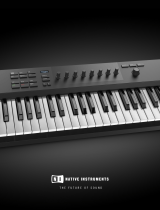 Native Instruments Komplete Kontrol A-Series 2.1.3 User manual
Native Instruments Komplete Kontrol A-Series 2.1.3 User manual
-
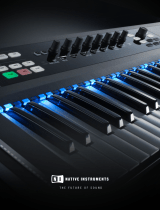 Native Instruments Komplete Kontrol S-series MK1 User manual
Native Instruments Komplete Kontrol S-series MK1 User manual
-
Novation Launch Control Owner's manual
-
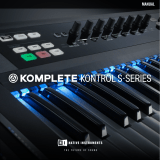 Native Instruments Komplete Kontrol 1.8 S-Series User manual
Native Instruments Komplete Kontrol 1.8 S-Series User manual
-
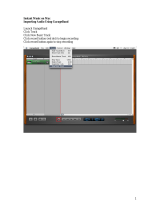 ADS Technologies RDX-152 Software Manual
ADS Technologies RDX-152 Software Manual
-
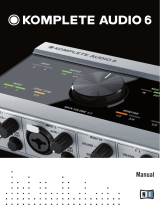 Native Instruments Komplete Audio 6 User manual
Native Instruments Komplete Audio 6 User manual
-
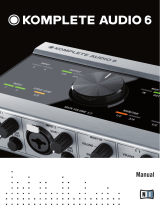 Native Instruments Komplete Audio 6 User manual
Native Instruments Komplete Audio 6 User manual
-
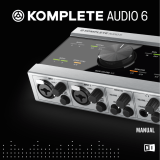 Native Instruments Komplete Audio 6 User manual
Native Instruments Komplete Audio 6 User manual
-
M-Audio Oxygen Pro 61 Quick start guide
-
M-Audio Oxygen Pro 61 Quick start guide






















































































































































































